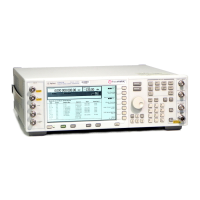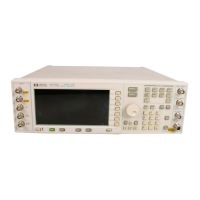Chapter 8 257
Bluetooth Signals
Setting up Impairments
Setting up Impairments
The steps in this procedure build upon the previous procedure. This procedure teaches you how to set up the
parameters for the impairment function.
1. Press
Return > Return > Impairments.
This accesses a menu which enables you to set up impairments.
2. Press
Freq Offset > 25 > kHz.
3. Press
Freq Drift Type Linear Sine.
This sets the frequency drift type to linear. Linear frequency drift will occur across a period of time equal
to the duration of one fully loaded DH1 packet, regardless of the packet length. The default setting is the
sine drift deviation which is plus or minus from the carrier center frequency.
4. Press
Drift Deviation > 25 > kHz.
This sets the maximum deviation of the frequency drift of the carrier frequency.
5. Press
Mod Index > .325 > Enter.
Modulation index is defined as the ratio of peak-to-peak frequency deviation to the bit rate. When
modifying the Mod Index parameter, the peak-to-peak frequency deviation only is changed.
6. Press
Symbol Timing Err > 1 > ppm.
This sets the symbol timing error in parts per million.
7. Press
AWGN.
This accesses a menu from which you can select the parameters of the additive white Gaussian noise
(AWGN) to be applied as an impairment to the Bluetooth signal. The following parameters may be
changed while AWGN is off, but will not be applied unless
AWGN and Impairments are both turned on.
a. Press
C/N [1MHz] > 20 > dB.
This sets the carrier-to-noise ratio for a 1 MHz bandwidth.
b. Press
Noise Seed > 2 > Enter.
This sets the noise seed value used to assign a specific sequence of noise to be added to the basic
Bluetooth signal. The noise seed is used to initialize the 16-bit shift register used for noise
generation. Different noise seeds generate different combinations of noise.
c. Press
AWGN Off On to On.
This turns the AWGN, as a Bluetooth impairment, on.

